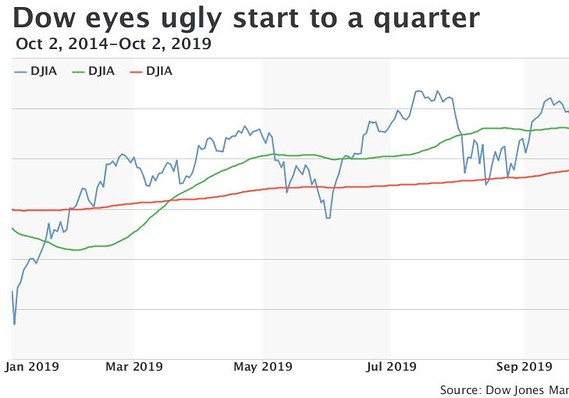 Dow Jones Market Data
Dow Jones Market Data U.S. equity markets on Tuesday were in a two-day tailspin that threatens to push the benchmark indexes to one of the worst starts to a quarter since the 2008-09 financial crisis.
The Dow Jones Industrial Average DJIA, -2.05%, was down more than 500 points, or 2%, at 26,050, with a two-session skid of about 3%, representing the worst start to a quarter since the last three months of 2008, when the Dow slumped 19.4% in the fourth quarter, according to Dow Jones Market Data.
Already considered an unusually volatile period for the stock market, which has logged historically ugly October declines in 1929, 1987 and 2008, worries about geopolitics and growing signs of domestic and international economic weakness have fueled bearish bets and sent stock-market optimists, at least momentarily, scurrying for cover in assets perceived as safe.
Read: Stocks just delivered a reminder about October’s reputation for volatility
See: Here’s how the stock market tends to trade in the rest of the year after an ugly
The 10-year Treasury yield TMUBMUSD10Y, -2.78% was down 5 basis points to 1.59%, while gold futures GCZ19, +1.38% were surging 1.1%, retaking a bullish perch for the haven asset at $1,500 an ounce.
Meanwhile, the broader market also was on track for its worst start to a quarter, with trading in the first two sessions in October putting the S&P 500 index SPX, -1.98% on pace to fall at least 2.9% to start the quarter, which would represent its worst such start since a 5.49% skid in fourth quarter of 2009.
The Nasdaq Composite Index COMP, -1.81%, down 2.7% so far in October, and the Russell 2000 index RUT, -1.30%, off 3.1%, were set for their worst starts to the quarter since 2009.
Reflecting the slump in the equity indexes, one reading of implied stock-market volatility, the Cboe Volatility Index VIX, +11.58%, a gauge of bullish and bearish S&P 500 options bets that tends to rise as stocks fall, was on pace for its biggest rise to a quarter on record. The so-called fear index was up about 29% in the first two days of October, which would eclipse the 24.58% gain for the index back in the fourth quarter of 1992.
Helping to stoke bearish sentiment on Wednesday was a private-sector employment report from Automatic Data Processing ADP, -2.77%, which showed that a modest 135,000 jobs were created in September, in another sign that hiring is slowing along with the broader U.S. economy. The data comes a day after the Institute for Supply Management’s manufacturing survey produced its worst reading since 2009.
Evidence of a slowdown in the U.S. economy also comes amid a persistent Sino-American dispute over tariffs and intellectual property rights between the world’s largest economies.
Worries about Britain’s exit from the European Union, and developments related to President Donald Trump’s impeachment inquiry over allegations that he has been using the power of the Oval Office to undermine democratic elections, were also concerning investors.
“Stocks are firmly in the red as fears about a recession have gripped the markets. The dreadful ISM manufacturing reading from yesterday is stilling playing on traders’ minds,” wrote David Madden, market analyst at CMC Markets, in a Wednesday research note. “The ADP report added to the worries the US economy is slowing down.”
-Ken Jimenez contributed to this article










Add Comment